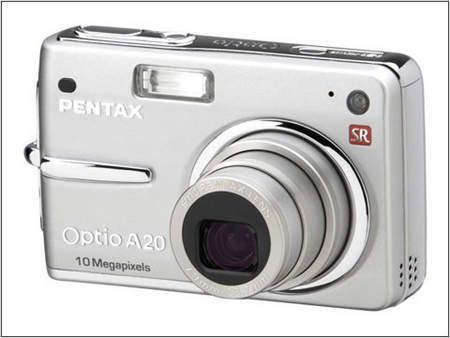So often these days a 10-megapixel compact means images full to bursting with noise, Fuji has gone a long way to controlling that noise in its cameras and on the evidence of this camera, Pentax has been working hard to subdue it too.
Our quick take
Pentax has been a consistent performer in terms of the good quality of cameras it launches and the A20 continues that trend. It has a great feature set; even exposure compensation, a great lens and a sensor that despite the high resolution, still controls noise well. Picture quality is as a result simply superb and I can heartily recommend this camera.

Pentax Optio A20 digital camera - 4.5 / 5
| FOR | AGAINST |
|---|---|
|
|
The A20 is a neatly designed, well-made compact featuring innovations that help to set it apart from the 10-megapixel pack. The A20 has an advantage with its sensor, a larger-than-most-10-megapixel, 1/1.8-inch type CCD controlled by a new image-processing engine or ASIC (Application Specific Integrated Circuit) so noise is reduced and sensitivity improved.
Much is made of anti-shake these days and usually for a 3x-zoom, the A20 also employs it but in three forms. There’s Pentax’s proprietary CCD-shift system to help with camera shake, there’s special high-sensitivity anti-blur system to help reduce blur from subject movement by boosting the sensitivity up to ISO 1600 so faster shutter speeds remain available. The downside of the anti-blur mode is it fixes the resolution to 5-megapixels and noise does become obvious.
Finally, the anti-shake system can be rolled out into the movie mode as well, but it uses software to reduce blur and this has the unfortunate side effect of reducing the field of view available to the camera’s sensor and introduces extra noise and reduces detail a tad as well.
The lens on the camera is a neat 38-114mm F2.8-F5.4 optic that is both bright and provides excellent clarity, helping to make the most of the camera’s many pixels, making the A3+ print size output it’s capable of, a reality.
Other features include a large 2.5-inch colour screen – although this comes at the expense of an optical viewfinder – that’s quite hard to use in direct sunlight. Shooting modes include a point and shoot green mode (with its own button that can be assigned other functions if required) and 15-scene modes such as night scene, portrait and landscape for example. It also boasts an auto picture mode that can detect the type of scene you’re about to shoot and will automatically pick a suitable scene mode setting to use for the shot.
Face “recognition” AF and AE combine to good effect with the camera able to spot and track a face within a shot. It works well enough at tracking a face but takes a while to settle on a subject and lock on, making it quite slow to use.
There’s a good super macro setting that works well and gets the most from the lens with sack-loads of detail and great control of the depth of field, crucial for macro work. The camera’s sensitivity runs through ISO 64, 100, 200, 400 and 800 with the 1600 mode only available to the aforementioned anti-blur setting. Noise control is very good up to ISO 400, but suffers increasingly beyond that.
Metering is spot on my shots, even a shot directly into the sun has been coped with well despite obvious lens flare, which, to be fair, would adversely affect any camera’s lens. Other neat kit includes basic, in-camera movie editing; redeye reduction and digital filters that include brightness and special effects, black and white and colour skew among others.
A couple of quibbles that spoil camera handling revolve around the manual shooting settings. You have shutter priority and Program AE to play with, plus full Manual control; you can control the shutter speeds and apertures. However, the increments between apertures in manual (or really the lack of them) are just F2.8 or F8, so very limiting. That and the fact you must first set the aperture and shutter speeds and then okay the chosen settings prior to using them makes it a little clumsy and slow to use, but these are rare demerits.
To recap
The A20 is a superbly specified digital compact that lacks almost nothing in terms of specification and control and at a great price
